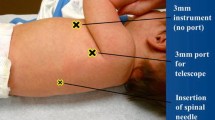Background: The purpose of this study was to evaluate the feasibility and limitations of laparoscopic repair of traumatic diaphragmatic injuries. Methods: Laparoscopic repair of an acute traumatic diaphragmatic laceration or chronic traumatic diaphragmatic hernia was attempted in 17 patients between January 1997 and January 2001. The patients in the study included 13 men and 4 women with a mean age of 33.2 years (range, 15–63 years). Nine patients had a blunt injury, and eight patients had a penetrating injury. Laparoscopic repair was attempted for eight patients during their hospitalization for the traumatic injury (mean, 2.3 days; range, 0–6 days) and for ten patients with a chronic diaphragmatic hernia (mean, 89 months; range, 5–420 months). The chronic diaphragmatic hernias-presented with abdominal pain (9/9), or vomiting (3/9). Results: Thirteen traumatic diaphragmatic injuries were repaired laparoscopically, and four (2 acute and 2 chronic) required conversion. Among the laparoscopically repaired diaphragmatic injuries, three defects (chronic) were repaired using expanded polytetrafluoroethylene (ePTFE), and nine were repaired primarily. The mean length of the diaphragmatic defects was 4.6 cm (range, 1.5–12 cm). The mean operative time was 134.7 min (range, 55–200 min). The mean estimated blood loss was 108.5 ml (range, 30–500 ml), and the postoperative length of stay was 4.4 days (range, 1–12 days). There were no intraoperative complications, but three patients developed pulmonary complications (atelectasis/pneumonia). Follow-up evaluation was available for 11 patients. There were no documented recurrences after a mean follow-up period of 7.9 months (range, 1 week to 24 months). Conversion resulted from a reluctance or inability to perform laparoscopic suture of transverse diaphragmatic lacerations longer than 10 cm anterior to the esophageal hiatus and adjacent to the pericardium (n = 2) or communicating with the esophageal hiatus (n = 2). One patient also required spleneotomy for an unrecognized splenic laceration that had occurred at the time of the original trauma. The four patients undergoing laparotomy had a mean postoperative discharge date of 8.7 days (range, 6–14 days). Conclusions: Laparoscopy is an alternative approach to repairing acute traumatic diaphragmatic lacerations and chronic traumatic diaphragmatic hernias. Large traumatic diaphragmatic injuries adjacent to or including the esophageal hiatus are best approached via laparotomy.
Similar content being viewed by others
Author information
Authors and Affiliations
Rights and permissions
About this article
Cite this article
Matthews, B., Bui, H., Harold, K. et al. Laparoscopic repair of traumatic diaphragmatic injuries . Surg Endosc 17, 254–258 (2003). https://doi.org/10.1007/s00464-002-8831-9
Received:
Accepted:
Issue Date:
DOI: https://doi.org/10.1007/s00464-002-8831-9




